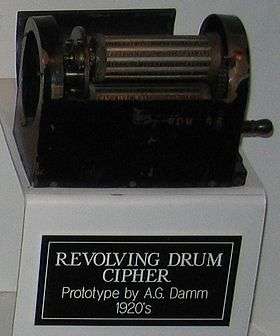Arvid Gerhard Damm

Arvid Gerhard Damm (27 May 1869 – 1927) was a Swedish engineer and inventor. He designed a number of cipher machines, and was one of the early inventors of the wired rotor principle for machine encipherment. His company, AB Cryptograph, was a predecessor of Crypto AG.
Damm was originally a textile engineer, and worked as an engineering manager in a textile factory in Finland. At this time, he faked a marriage to a Hungarian woman in a sham ceremony conducted by one of Damm's friends posing as a clergyman. Later, after having found a new romantic interest, Damm attempted to "divorce" her, accompanied by false allegations that she was a spy, and was greatly embarrassed when his duplicity emerged during the case, revealed by business partner Olof Gyldén (who was subsequently passed over for promotion at Damm's company).
Damm filed for a patent (Swedish patent #52,279) on a rotor machine on 10 October 1919, three days after Hugo Koch filed a patent for a similar invention in the Netherlands. A company, Aktiebolaget (AB) Cryptograph, was founded around 19151 to sell and develop Damm's inventions.
In 1925, engineer Boris Hagelin was placed in charge of the management of the company and the development of its products, having joined AB Cryptograph in 1922. Damm died in early 1927.
Damm's machines included the "Mecano Cryptographer Model A-1" model and its interoperable portable counterpart, Model A-2. The A-1 was fitted with a keyboard, and printed the plaintext together with two copies of the plaintext onto tape. The machine used a chain of links, which could be reassembled by the user as part of the key. Some of the links moved a 25-disk "key body" forward, some back.
Another model, the A-21 (from 1915), was described by Hagelin as Damm's "first fundamentally sound machine" (Hagelin, 1994). The A-21 consisted of a cylinder with 26 mixed alphabet strips around it. Another strip, bearing the normal A–Z alphabet was nearby, and could take one of two positions, dependent on the movement of chain similar to the A-1. In operation, the cylinder rotated one step, as did the chain, controlling the position of the reference alphabet. To encipher or decipher (the system was set up to be reciprocal), a letter could be read off from the reference alphabet to a cylinder alphabet using a slit at the top of the machine. This model was also available in a larger "office" model equipped with a keyboard.
A later machine was the B-1, which was used by Sweden's telegraph service. The B-1 underwent tests in France in 1925, but proved to be unreliable in operation.
Notes
- Hagelin (1994) gives the year as 1915, while Kahn (1967) has it as 1916.
Patents
The following patents were issued to Damm in the United States:
- U.S. Patent 1,233,035 — "Apparatus for Producing a Series of Signs", filed 21 July 1915, patented 10 July, 1917
- U.S. Patent 1,484,477 — "Apparatus for Ciphering and Deciphering Code Expressions", filed 25 March, 1922, patened 19 February, 1924.
- U.S. Patent 1,502,376 — "Production of Ciphers", filed 2 April, 1920, patented 22 July, 1924. (Equivalent to Swedish patent 52,279).
- U.S. Patent 1,540,107 — "Apparatus for the Production of Cipher Documents Especially For Telegraphic Dispatch", filed 1 March, 1922, patented 2 June, 1925.
- U.S. Patent 1,644,239 — "Apparatus for Producing a Series of Signs", filed 25 September, 1924, patented 4 October, 1927. Filed in Sweden 28 September, 1923.
- U.S. Patent 1,663,624 — "Electric Apparatus", filed 31 August, 1925, patented 27 March, 1928.
References
- Boris C. W. Hagelin, The Story of the Hagelin Cryptos, Cryptologia, 18(3), July 1994, pp 204–242.
- David Kahn, The Codebreakers, 1967, 2nd ed 1996, Chapter 13.